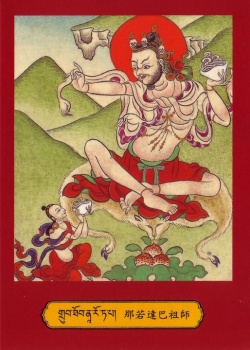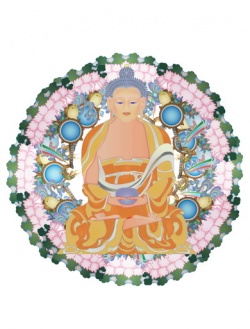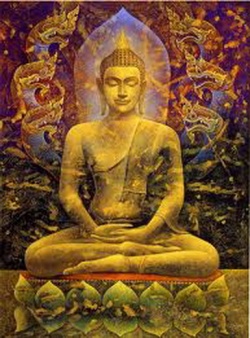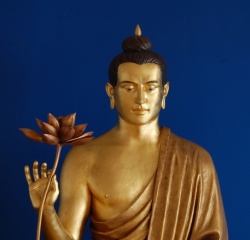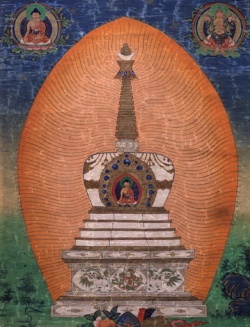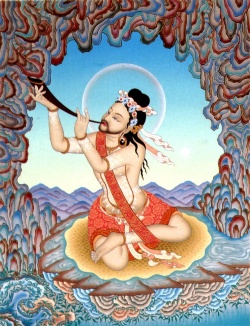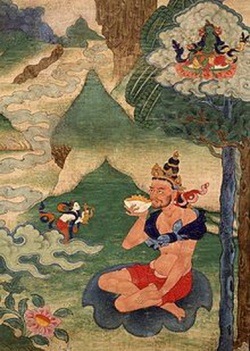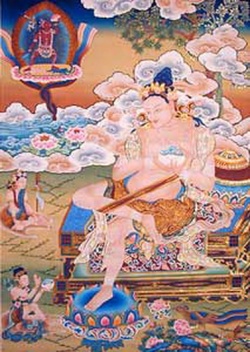Mahasiddha Naropa
According to 'The Wand that Opens the Eyes and Dispels the Darkness of Mind' (the abridged collection of biographies of the successive Gyalwang Drukpas), Naropa was born around AD 956 and passed away around AD 1050. However, other sources record him as living between AD1016 and 1100. Naropa was born in the small kingdom of Bengal. His father was a royal chieftain of an area named Shantivarman and his mother was called Srimati. His yearning for spiritual development was so strong that, when he was eight years old, he journeyed to Kashmir (one of the main seats for Buddhist studies in historical times) in order to study with the master Gaganakirti. It was from Gaganakirti that he received his lay ordination.
Naropa remained in Kashmir for three years, learning Buddhist teachings and philosophies from many great masters. By the end of his stay there he was an erudite scholar and, upon returning home, already had a number of students following him as their master.
Tilopa (an ancient mural in Hemis Monastery, Ladakh)Three years after his return from Kashmir, Naropa was forced by his parents to marry a lovely Brahmin girl, Vimaladipi (also known by her caste name, Niguma). Although they were happily married, Naropa's ardent wish to live a full spiritual life in a monastic environment became increasingly strong and Niguma also began to take spiritual practice seriously. After eight years of marriage, the couple decided to divorce and take ordination orders. Later, Niguma became one of Naropa's most advanced disciples and a devoted spiritual companion; she served Naropa when he lived in Pullahari, Kashmir.
After the divorce, Naropa went to the hermitage of Anandarama, where he was ordained as a novice by Abbot Buddhasarana and the guru Jnanaprabha, with whom he stayed for three years, mastering various Mahayana and Tantrayana philosophies. He then stayed in Pullahari for six years and wrote several commentaries on Guhyasamajatantra, Abhidharma-uttaratantra, Samvara-udbhava and Hevajratantra and composed many other works based on the Buddha's teachings. Pullahari later became an important pilgrimage site in the Tibetan Buddhist tradition, because it was one of the places where Marpa received instructions from Naropa.
The cave along a river in Mandi, where Naropa met Tilopa, his destined guru Where Naropa flew up into the sky, in the six bone ornaments offered by Dakini (Sani Monastery, Zanskar)After his stay in Pullahari, Naropa went to Nalanda University, where his wisdom, oratory skills and spiritual understanding earned him the chancellorship of the university. He also became the 'Northern Gatekeeper'. Throughout his eight years' residence at Nalanda he was constantly faced with difficult debates with the Tirthikas, but was regularly victorious in these. At this time, he was known as Mahapandita Ahbaya Kirti (Tib. Jigme Dragpa).
Naropa's years at Nalanda were mostly engaged in intellectual activities until an old and ugly woman - who was in fact a manifestation of Vajra Yogini - appeared before him and made him realize that he was not managing to break through his spiritual misconceptions and misunderstandings. She pointed out that he should look for his destined guru Tilopa if he wished to attain Ultimate Liberation. As a result of this meeting Naropa left Nalanda, searching earnestly for Tilopa - a great master who could lead him to realize the ultimate nature of his own mind.
Traveling eastward, Naropa finally met his destined root guru, who instantly put him through difficult tests. Naropa experienced twelve major and twelve lesser hardships in order to purify his karma and emotion-induced obscurations. Through receiving great blessings from Tilopa and accomplishing his own purification, Naropa realized the clarity and harmony of mind - truly experiencing the state of Vajradhara. After attaining this magnificent realization, Naropa taught in many places and had numerous disciples, especially in Kashmir and Zanskar where he established many monasteries.
Inside this particular statue of Naropa is the golden Vajradhara statue (Sani Monastery, Zanskar) Dzongkhul Monastery, where Naropa meditated (Zanskar)According to His Holiness the Twelfth Gyalwang Drukpa, Sani is also the place where Naropa flew up into the sky upon attaining enlightenment whilst wearing the renowned Six Bone Ornaments. Naropa meditated in a small hut facing the Kanishka stupa and taught the people of Sani for a number of years. When it was time for Naropa to leave, the local people sincerely begged him to stay.
Naropa took out a golden Vajradhara statue from the hair knot on his crown and said, "There is no difference between Vajradhara and me. Venerate this statue of Vajradhara just as you are venerating me and you will get the same blessing."
Naropa left after handing over the golden statue to the local people; today, this is kept in the heart of a very special Naropa statue, which is unveiled once a year in late July on the eve of the Naro-Nasjal festival. People from all over the Zanskar valley participate in this festival, at which time monks from the Drukpa Bardan Monastery perform mask dances as well as ritual offerings.
The arrow used by Naropa, Dzongkhul Gompa, Zanskar Naropa spent twelve years serving his guru Tilopa until the latter's death. Naropa himself was said to live until AD1050 or 1100 (according to the different sources) and then resurrected into light, leaving no physical remains. Tilopa and Naropa are both recognized as two of the eighty-four great mahasiddhas in the history of Buddhism.
Amongst Naropa's accomplished disciples was Marpa, the translator, who succeeded Naropa in the lineage and brought the teachings and transmissions in their entirety to Tibet.
The origin of the Six Ornaments of Naropa goes back to the eleventh century. At this time, the Tibetan translator Marpa Choekyi Lodro of Lhodrak visited India three times and Nepal four times, encountering hundreds of erudite and accomplished Masters.
His principal Gurus were the learned Naropa and Lord Maitripa from whom he received the complete empowerments, and the essential instructions that contain the ultimate meaning of all the Sutras and Tantras. Under these Masters, he also studied the extraordinary teachings of Mahamudra and the Six Yogas of Naropa. By perfectly accomplishing those practices, he obtained full and ultimate realization.
The crown ornament of Naropa His Holiness Gyalwang Drukpa putting on the Six Ornaments of Naropa for the second time (Ladakh, 1992)Finally, Lord Naropa declared to Marpa: "The blessings of Master Krishnacharya breathed life into the lineages of Eastern regions, the Master Aryacharya has blessed the lineage of the South, and the King Indrabhodi transmitted his spiritual influence to the Western lineages. I bestow the waves of grace to the lineages of the North, the Lands of Snow. You have nothing more to do here - return to Tibet. I impart to you the power of my legacy; I appoint you my regent on the Roof of the World. The Land of Snow abounds in potential disciples, worthy vessels for my teachings."
Following this declaration, Lord Naropa offered to Marpa the bone ornaments, which he was wearing and his rosary of rubies, as well as other ritual objects. Lord Naropa laid his noble hands upon the head of his regent Marpa, blessed him and gave him more instructions and then left to engage in victorious activity in all directions, beyond mundane existence.
Thus the Lord Marpa returned to Tibet. He released there the essence of the teachings, turning the wheel of ultimate truth for innumerable amount of students. Amongst his disciples were 'The Four Major Spiritual Sons' to whom he fully transmitted the four streams of oral instructions which he held.
One of these four great disciples was a sage inclined to give harmoniously flowing and ample explanations, like pearls of a necklace. His name was Ngokton Choku Dorje (1036-1102) and to him Marpa gave the particular transmission of the four classes of Tantras: root texts, sadhanas, essential commentaries and instructions. Marpa also entrusted him with the ritual objects which were the supports for the practice of Naropa and his Six Ornaments, announcing to Ngokton in a prophetic manner, " Keep these. Now for your forthcoming descendents, until the seventh generation, simply knowing how to hold vajra and bell will be sufficient for the Master himself to bestow the waves of grace."
His Holiness putting on the Six Ornaments of Naropa for the third time (July 2004)As he had prophesized, the Six Sacred Ornaments remained the possession of the Masters of the lineage of Ngok until the advent of the seventh generation, and they were venerated as devotional support.
Then came the time when the Seventh Ngok, Ngokton Jangchub (1360-1446), encountered the Gyalwang Drukpa - Kunga Paljor, the Second Incarnation. Ngonton Jangchu then granted the Gyalwang Drukpa the totality of the teachings transmitted in the lineage of Ngok, and offered him the Six Ornaments and the initiation vase of Lama Ngok, amongst other treasures. By proclaiming him holder of his teachings, he finally declared: "The Dharma returns in the hands of its Sovereign!" and he then announced that the Victorious Dragon was the Incarnation of the Lord Naropa.
Since then the incarnations of the Gyalwang Drukpa have successively inherited the Ornaments, which they kept as devotional support. The Gyalwang Drukpa offered them for viewing so that those fortunate beings who see them may accumulate merit.
NAROPA WAS BORN A PRINCE in India. From the day of his birth, he was a very exceptional being endowed with special qualities. As an infant, Naropa was so pleasant to behold that simply to gaze at him was to experience joy and a sense of happiness. Even in childhood, he possessed profound wisdom and a sense of loving-kindness and compassion for others.
The king, queen, and all the attendants agreed that the most appropriate place for such an extraordinary son of a noble family would be a monastery. Just as precious jewels should not be kept in filthy water but placed upon an immaculate shrine, it did not seem befitting for Naropa to dwell in the midst of worldly people. His rightful place was to be among practitioners of the Dharma.
When he came of age, Naropa was most happy with the decision for him to go to a monastery, and he went off to study with many scholars and become properly educated. Naropa's wisdom became so profound that he surpassed all of his teachers all of the time. He became one of the most famous and world-renowned scholars of his day and went to Nalanda University in India.
It was the custom at that time in India for different traditions to debate with each other, with the beliefs of the winner declared supreme. Hundreds of scholars of different traditions would come to Nalanda University to debate with Buddhist scholars. At that time, Nalanda had four gates at each of the cardinal directions. At each gate there were five hundred world-renowned scholars known as "gate keepers." Naropa became one of the scholars at the northern gate. In that capacity he debated daily with many scholars of various schools, and each day he further proved himself to be one of the most learned among them all. In this way he became very famous.
One day, as Naropa was sitting quietly in his room reading a Buddhist sutra text, a very fearful shadow fell upon the floor. He immediately looked up to see what it was. To his great surprise he saw a very ugly, wrinkled, old woman without a single tooth in her mouth standing in front of him. She was so old that she was not able to stand without the aid of a cane. She asked Naropa, "What are you reading?" Naropa replied, "I am studying the teachings of the Buddha." The old woman then asked, "Do you understand the teachings?" Without any hesitation Naropa replied, "I understand every single word of the teachings of the Buddha." This response elicited great joy and happiness in the old woman, and she laughed and giggled, and danced in an ecstatic manner. She said, "It is very fortunate for this earth that such a scholar as yourself exists!"
The ugly woman next asked Naropa, "You might understand the literal meaning of the teachings of the Buddha, but do you understand the inner and ultimate meaning of the teachings?" Since the old woman had displayed such great joy and happiness at his merely saying that he understood the literal meaning of the sutras, Naropa thought that she would be even more joyful if he said that yes, he understood the inner, essential meaning of the Dharma. So Naropa replied, "Yes." As he replied yes, the expression of the face of the ugly old woman turned from one of joy to one of sadness, and she fell to the floor and beat it with both her hands and cried, "To think that such a great scholar as you knows how to tell lies!" This embarrassed Naropa, who inquired," Is there anyone who really understands the inner meaning of the Dharma?" The old woman replied, "Yes, my brother, Tilopa."
The instant that she uttered the name "Tilopa," devotion arose in the mind and heart of Naropa and tears came to his eyes. Naropa asked the old woman,"Where can I find this master? In which direction does he reside?" The old woman replied, "There is no particular direction for Tilopa or his residence. He could be anywhere. If your mind is filled with devotion and confidence, and you yearn to meet him, this is the right direction." Having spoken thus, the old woman, who was actually Vajrayogini, disappeared like a rainbow fading in the sky. Because his negative karma was not completely purified, Naropa was only able to see her as a very ugly, old woman. His mental stains prevented him from seeing her true form.
Naropa requested leave from the Abbot of Nalanda University. He was a great favorite of the Abbot and scholars, and although they wanted very much for him to stay, he had made up his mind to leave and search for Tilopa.
With an intolerable yearning, Naropa went out in search of his master. He experienced extreme hunger and thirst and overexposure to the elements, but he did not allow any of these unbearable conditions to deter him in his search for Tilopa. The many unfavorable circumstances that he encountered have become known as the "Twelve Fearful Experiences of Naropa." Twelve times he encountered ferocious dogs, wild animals, poisonous snakes, terrifying women, and other adverse situations that hindered him on his path to meet his teacher and frightened him almost to death. Nevertheless, he would not turn back in his search for Tilopa. After each terrifying encounter he went forward, and each time he did this, he would hear an affirmation resounding from the sky that what he had just experienced was the manifestation of his guru.
After suffering the pain and hardships of passing through the "Twelve Fearful Experiences," Naropa found himself in a village. From out of the sky sounded the words, "Not far from this village is the master whom you seek. You must have faith and confidence in him." Filled with excitement, Naropa went to the outskirts of the village and asked everyone he saw if they knew a master called Tilopa. They all replied that they did not know a master called Tilopa, but there was a fisherman down by the river drying fish who was called by that name.
Naropa was surprised to hear that Tilopa was a fisherman but he immediately remembered that all his recent experiences had actually been manifestations of his guru, and he realized that if he had to meet his teacher in the form of a fisherman, it must be because of his impure mind. So without any doubt or hesitation, and with devotion and trust, he went down to the river to meet Tilopa. As he got closer, he could see Tilopa was transferring the consciousness of each fish to a pure realm with a snap of his fingers. Afterwards he would pick up each fish and bite off its head, discarding the head to one side, and placing the body to dry on the sand in preparation for taking it to market.
Naropa prostrated to Tilopa as a gesture of respect and asked to be accepted as his student. Tilopa scrutinized Naropa from head to toe three times and said, "No matter from what angle I look at you, you seem to be of a royal family. You look like royalty and speak like royalty, and yet you come here to be a student of a fisherman, one of a lowly caste. This is not at all proper."
Tilopa was about to take his leave, but Naropa, out of desperation and devotion, clung to Tilopa without any shame or embarrassment and again requested him to be his teacher. Saying neither yes nor no to Naropa's request, Tilopa walked away. Naropa tried to follow Tilopa, but although Tilopa appeared to be walking normally, and although Naropa was running, he was unable to catch up, no matter how fast he ran. Naropa could see the form of Tilopa in front of him, but he was unable to get closer. As this area in India was particularly hot and arid, it became very difficult for Naropa to keep running after Tilopa, and although he subjected himself to thirst, hunger, and fatigue, he was not able to catch up.
Eventually, Naropa saw Tilopa sitting on a very high cliff. He went over to him and prostrated, again requesting Tilopa to be his teacher. Tilopa responded by saying, "If you were really desperate and determined to learn about the teachings, you would obey my order to jump off this cliff without any hesitation because you would be able to understand how important it is to follow the commands of your master." Naropa jumped off the high cliff and fell to the ground. All his bones and joints were broken into many, many pieces. Tilopa went down to Naropa and inquired, "Are you experiencing any pain?" Naropa replied, "The pain is killing me!" This is how Naropa got his name. ("Na" in Tibetan means "pain," "ro" means "killing" and "pa" makes the word a noun.) Tilopa gently touched Naropa's body and all his broken bones joined together and were healed.
After undergoing so much suffering, Naropa once again asked Tilopa to give him the profound teachings. Tilopa said, "You are not yet pure enough to be introduced to the nature of mind!" With a wrathful expression, Tilopa removed his slipper and slapped the face of Naropa so hard that Naropa fainted. When he regained consciousness, Naropa's mental state of realization was equal to that of his teacher.
Becoming very peaceful, Tilopa lovingly explained to Naropa why he had to be so very wrathful and subject him to so much suffering. He explained, "The fact that I led you into so many painful circumstances does not mean that I am a cruel person. Your negative karma could not be purified by your own effort alone. Only by your actually experiencing hardship could you purify the negative karma that prevented you from realizing the ultimate nature of buddhahood. Throughout all your experiences of hardship, you did not develop any doubts, hesitation, or wrong views, and you diligently obeyed all commands. In this way you were able finally to overcome the conflicting emotions and experience realization."
If we compare the life stories of Milarepa and Naropa, both experienced extreme hardships. However, Naropa experienced more intense pain than Milarepa, but the duration of Milarepa's experiences was longer.
In case any of us might still be wondering if such harshness is really necessary to reach enlightenment, let us take the example of a vessel that is encrusted with rust. The rust on the metal container is so rough that trying to remove it with a soft cloth and gentle hand, we would not be able to remove any rust at all. The more effective way to remove the rust would be to find another very rough substance even rougher than the rust. If we rub the container with this, then the rust can be removed. Similarly, the negative karma obscuring the true nature of mind cannot be removed by softness or gentleness, nor can the achievement of realization occur if a teacher is overly kind. Harshness is needed. If a teacher allows his students to be lazy and is too soft-hearted, the students will be unable to uncover and purify their mental stains. Harshness and roughness on the part of the teacher are essential.
After Naropa reached the stage of realization equal to his teacher, Tilopa assured him that they were inseparable. They had never been separate in the past, were not separate in the present, and would never be separate in the future.
Tilopa and Naropa became so famous throughout India that in the eyes of the people they were as familiar as the sun and the moon. Renowned for their realization, wisdom, and profound learning, Tilopa and Naropa turned the wheel of Dharma uncountable times in all directions.
According to various sources like the lineage histories of the Karma Kagyu, Drukpa Kagyu or Drikung Kagyu, Naropa was born around the year 956 and passed away around 1050. Other sources record him as having lived between the years 1012 and 1100. (Bearing in mind that his main Tibetan student Marpa was born either in 1002 or 1012, 956 is rather more likely as Naropa's year of birth.)
Naropa was born in one of the many small kingdoms of Bengal. His father was a royal chieftain by name of Shantivarman and his mother was called Srimati. His yearning for a religious life was so strong that, when he was eight years old, he travelled to Kashmir, one of the main seats for Buddhist studies in ancient times, in order to study with the master Gaganakirti. It was from Gaganakirti that he received his lay ordination.
Naropa stayed in Kashmir for three years, studying Buddhist teachings and philosophies from many great masters. By the end of his stay there he was a highly learned scholar and, upon his return to his home country, already a number of students followed him as their master.
Some years after Naropa's return from Kashmir, his parents insisted that he marry a Brahmin girl, Vimaladipi, who later on became reknowned far and wide as the female Mahasiddha Niguma. Although they were happily married, both Naropa and Niguma longed strongly for a spiritual life of studies and practice. After eight years of marriage, they decided to both take ordination. Later, Niguma became one of Naropa's most advanced disciples and a devoted spiritual companion; she served Naropa while he lived in his monastery of Pullahari.
After having thus ended their marriage, Naropa went to the hermitage of Anandarama, where he took novice ordination from the abbot Buddhasarana and the guru Jnanaprabha. He stayed with Jnanaprabha for three years, studying and mastering various philosophical treatises. He then went to Pullahari and stayed there for six years. While there, he composed several commentaries on the Guhyasamaja-tantra, Abhidharma-uttaratantra, Samvara-udbhava and Hevajra-tantra and commmented upon many other buddhist works. It was in Pullahari where later on Naropa's Tibetan disciple Marpa received many empowerments and instructions from him.
After his prolonged stay in Pullahari, Naropa went to Nalanda University, where his wisdom, skills in debate and teaching, as well as his deep spiritual understanding earned him the chancellorship of the university. He also became the "Keeper of the Northern Gate". Throughout his eight year tenure at Nalanda he was constantly engaged in difficult debates with the Tirthikas, but remained victorious each and every time. At this time, he was known as Mahapandita Abhaya Kirti.
Naropa was mostly engaged in intellectual activities until an old and ugly woman, who in fact was an emanation of Vajra Yogini, appeared before him and made him realize that all his intellectual knowledge had not brought him a single step closer to spiritual realisation. She told him to look for "her brother", his destined guru Tilopa, if he wished to attain true realisation and ultimate liberation. After this encounter, Naropa left Nalanda, searching far and wide for Tilopa, the master who would eventually lead him to the full realisation of Mahamudra.
Travelling towards the east, Naropa finally met his root guru Tilopa, who initially ignored him completely. Naropa was then put through twelve major and twelve lesser trials in order to purify his negative karma and emotional defilements and obscurations. Through the blessings from Tilopa and bringing about his own purification, Naropa realised the clarity and emptiness of mind-nature, and achieved the unified state of Vajradhara. After attaining this magnificent realisation, Naropa taught in many places and had numerous disciples, particularly in Kashmir and Zanskar where he established many monasteries.
Altogether, Naropa spent twelve years serving his guru Tilopa until the latter passed away. Naropa himself is believed to have lived until 1050 or 1100 (according to the different sources) and then attained the so-called rainbow body of great transformation, leaving no physical remains behind. Tilopa and Naropa are both counted among the Eighty-four Mahasiddhas of India.
Amongst Naropa's accomplished disciples was Marpa the translator, who became one of his lineage-holders. He brought Naropa's teachings to Tibet, translated and spread them there, and became thus the founder of the Kagyu lineages.
